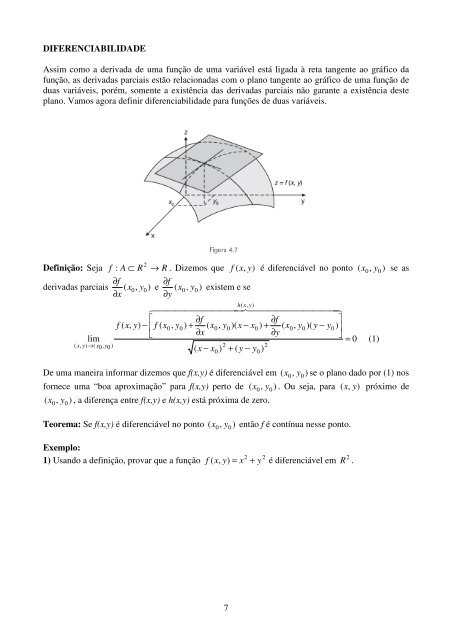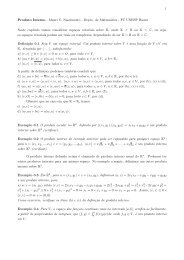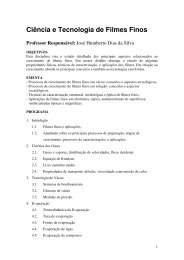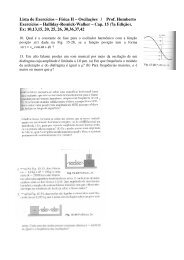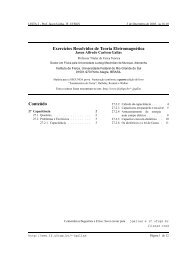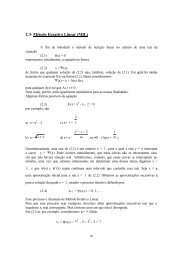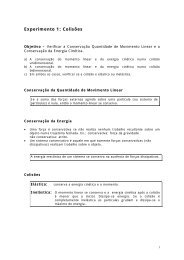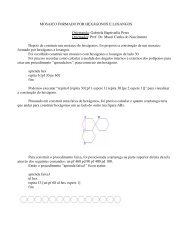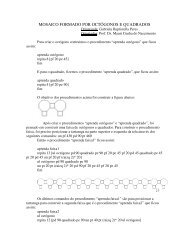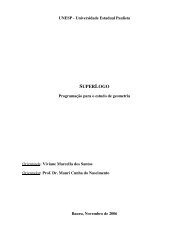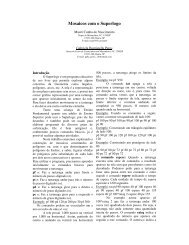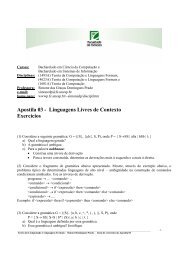7 DIFERENCIABILIDADE Assim como a derivada de uma função de ...
7 DIFERENCIABILIDADE Assim como a derivada de uma função de ...
7 DIFERENCIABILIDADE Assim como a derivada de uma função de ...
Create successful ePaper yourself
Turn your PDF publications into a flip-book with our unique Google optimized e-Paper software.
<strong>DIFERENCIABILIDADE</strong><br />
<strong>Assim</strong> <strong>como</strong> a <strong><strong>de</strong>rivada</strong> <strong>de</strong> <strong>uma</strong> <strong>função</strong> <strong>de</strong> <strong>uma</strong> variável está ligada à reta tangente ao gráfico da<br />
<strong>função</strong>, as <strong><strong>de</strong>rivada</strong>s parciais estão relacionadas com o plano tangente ao gráfico <strong>de</strong> <strong>uma</strong> <strong>função</strong> <strong>de</strong><br />
duas variáveis, porém, somente a existência das <strong><strong>de</strong>rivada</strong>s parciais não garante a existência <strong>de</strong>ste<br />
plano. Vamos agora <strong>de</strong>finir diferenciabilida<strong>de</strong> para funções <strong>de</strong> duas variáveis.<br />
Definição: Seja f<br />
: A R → R . Dizemos que f ( x,<br />
y)<br />
é diferenciável no ponto x , ) se as<br />
⊂ 2<br />
∂f<br />
<strong><strong>de</strong>rivada</strong>s parciais ( x 0,<br />
y ∂f<br />
0)<br />
e ( , 0 )<br />
∂x<br />
x 0<br />
∂y<br />
y existem e se<br />
lim<br />
( x,<br />
y)<br />
→(<br />
x0 , y0 )<br />
64444444444<br />
74444444444<br />
8<br />
⎡ ∂f<br />
∂f<br />
⎤<br />
f ( x,<br />
y)<br />
− ⎢ f ( x0,<br />
y0<br />
) + ( x0,<br />
y0<br />
)( x − x0<br />
) + ( x0,<br />
y0<br />
)( y − y0<br />
) ⎥<br />
⎣ ∂x<br />
∂y<br />
⎦<br />
= 0<br />
2<br />
2<br />
( x − x ) + ( y − y )<br />
0<br />
h(<br />
x,<br />
y)<br />
0<br />
( 0 y 0<br />
De <strong>uma</strong> maneira informar dizemos que f(x,y) é diferenciável em x , ) se o plano dado por (1) nos<br />
( 0 y 0<br />
(1)<br />
fornece <strong>uma</strong> “boa aproximação” para f(x,y) perto <strong>de</strong> x , ) . Ou seja, para ( x , y ) próximo <strong>de</strong><br />
( 0 y 0<br />
( x 0,<br />
y 0)<br />
, a diferença entre f(x,y) e h(x,y) está próxima <strong>de</strong> zero.<br />
Teorema: Se f(x,y) é diferenciável no ponto x , ) então f é contínua nesse ponto.<br />
( 0 y 0<br />
Exemplo:<br />
1) Usando a <strong>de</strong>finição, provar que a <strong>função</strong><br />
2<br />
2<br />
f ( x,<br />
y)<br />
= x + y é diferenciável em<br />
2<br />
R .<br />
7
2) A <strong>função</strong><br />
f<br />
⎧<br />
2<br />
x<br />
⎪ , ( x,<br />
y)<br />
≠ (0,0)<br />
2<br />
x,<br />
y)<br />
= ⎨ x + y<br />
é diferenciável na origem?<br />
⎪<br />
⎩0,<br />
( x,<br />
y)<br />
= (0,0)<br />
(<br />
2<br />
Proposição (Condição suficiente para diferenciabilida<strong>de</strong>): Seja x , y ) ∈ D(<br />
) . Se f(x,y) possui<br />
( 0 0 f<br />
∂f<br />
∂f<br />
<strong><strong>de</strong>rivada</strong>s parciais e em um conjunto aberto A que contém ( x 0,<br />
0)<br />
∂x<br />
∂y<br />
y e se estas <strong><strong>de</strong>rivada</strong>s<br />
parciais são contínuas em x , ) , então f é diferenciável em x , ) .<br />
( 0 y 0<br />
( 0 y 0<br />
Exemplos:<br />
2 2<br />
1) Verifique que a <strong>função</strong> f ( x,<br />
y)<br />
= sen(<br />
x + y ) é diferenciável em<br />
2<br />
R .<br />
2) Em que conjunto a <strong>função</strong><br />
2<br />
2<br />
f ( x,<br />
y)<br />
= x + y é diferenciável?<br />
8
PLANO TANGENTE<br />
Definição: Seja f : A R → R <strong>uma</strong> <strong>função</strong> diferenciável no ponto ( x 0,<br />
y 0)<br />
, chamamos <strong>de</strong> plano<br />
tangente ao gráfico <strong>de</strong> f no ponto (x 0 ,y 0 ,f(x 0 ,y 0 )) ao plano dado pela equação:<br />
∂f<br />
∂f<br />
z = f ( x0,<br />
y0<br />
) + ( x0,<br />
y0)(<br />
x − x0<br />
) + ( x0,<br />
y0<br />
)( y − y0<br />
) .<br />
∂x<br />
∂y<br />
⊂ 2<br />
Exemplos:<br />
1) Determinar se existir, o plano tangente ao gráfico da <strong>função</strong><br />
2<br />
2<br />
z = x + y no ponto (1,1,2).<br />
2) Determinar se existir, o plano tangente ao gráfico da <strong>função</strong><br />
2<br />
2<br />
z = x + y no ponto (0,0,0).<br />
9
VETOR GRADIENTE<br />
Utilizando produto escalar <strong>de</strong> dois vetores, a equação do plano tangente po<strong>de</strong> ser reescrita <strong>como</strong>:<br />
⎛ ∂f<br />
∂f<br />
⎞<br />
z = f ( x0,<br />
y0<br />
) + ⎜ ( x0,<br />
y0<br />
), ( x0,<br />
y0<br />
) ⎟.(<br />
x − x0,<br />
y − y0<br />
)<br />
⎝ ∂x<br />
∂y<br />
14444<br />
24444<br />
3⎠<br />
Vetor gradiente <strong>de</strong> f em (x 0 ,y 0 )<br />
Definição: Seja f ( x,<br />
y)<br />
<strong>uma</strong> <strong>função</strong> que admite <strong><strong>de</strong>rivada</strong>s parciais em <strong>de</strong> primeira or<strong>de</strong>m em<br />
( x 0,<br />
y 0)<br />
. O vetor ⎛ ∂f<br />
∂f<br />
⎞<br />
∇ f ( x0,<br />
y0<br />
) = ⎜ ( x0,<br />
y0<br />
), ( x0,<br />
y0<br />
) ⎟<br />
⎝ ∂x<br />
∂y<br />
⎠<br />
<strong>de</strong>nomina-se gradiente <strong>de</strong> f em (x 0 ,y 0 ).<br />
Notação: ∇ f x 0,<br />
y ) ou grad f x 0 , y )<br />
( 0<br />
( 0<br />
Geometricamente, interpretamos ∇ f x 0,<br />
y ) <strong>como</strong> um vetor aplicado no ponto x , ) , isto é,<br />
( 0<br />
transladado paralelamente da origem para o ponto x , ) .<br />
( 0 y 0<br />
( 0 y 0<br />
Analogamente <strong>de</strong>finimos vetor gradiente <strong>de</strong> funções <strong>de</strong> mais <strong>de</strong> duas variáveis. Para <strong>uma</strong> <strong>função</strong> <strong>de</strong><br />
três variáveis por exemplo temos:<br />
⎛ ∂f<br />
∂f<br />
∂f<br />
⎞<br />
∇ f ( x0,<br />
y0,<br />
z0<br />
) = ⎜ ( x0,<br />
y0<br />
), ( x0,<br />
y0<br />
), ( x0,<br />
y0<br />
) ⎟<br />
⎝ ∂x<br />
∂y<br />
∂z<br />
⎠<br />
Exemplo:<br />
2 2<br />
1) Seja f ( x,<br />
y)<br />
= x + y . Calcule ∇ f (1,1 ) e represente graficamente este vetor.<br />
Proposição: Seja f(x,y) <strong>uma</strong> <strong>função</strong> tal que pelo ponto P x , ) passa <strong>uma</strong> curva <strong>de</strong> nível C k <strong>de</strong> f.<br />
0 ( 0 y0<br />
Se ∇ f x 0,<br />
y ) for não nulo, então ele é perpendicular à curva C k em x , ) , isto é, ∇ f x 0 , y ) é<br />
( 0<br />
perpendicular à reta tangente à curva C k no ponto x , ) .<br />
( 0 y 0<br />
Esta proposição po<strong>de</strong> ser generalizada para funções <strong>de</strong> três:<br />
( 0 y 0<br />
( 0<br />
Proposição: Seja f(x,y,z) <strong>uma</strong> <strong>função</strong> tal que, através <strong>de</strong> um ponto P x , y , ) passa <strong>uma</strong><br />
0 ( 0 0 z0<br />
( x0,<br />
y0,<br />
z0<br />
superfície <strong>de</strong> nível S k <strong>de</strong> f. Se ∇ f ( x0,<br />
y0,<br />
z0<br />
) for não nulo, então ∇ f ) é normal a S em P 0 .<br />
OBS: Futuramente, quando estudarmos máximos e mínimos <strong>de</strong> funções <strong>de</strong> duas variáveis, veremos<br />
que os pontos <strong>de</strong> máximo e mínimo locais <strong>de</strong> <strong>uma</strong> <strong>função</strong> diferenciável estão on<strong>de</strong> ∇f = 0 .<br />
Exemplos:<br />
10


